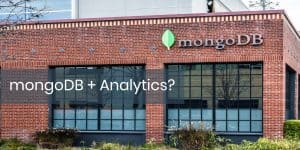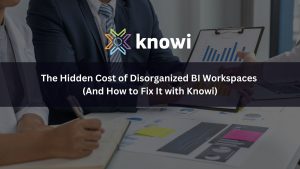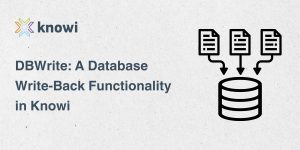In the rapidly evolving digital world, managing vast amounts of data has become a monumental challenge for organizations. As we navigate through the sea of data management terminologies, it’s crucial to understand the concept of a data fabric and its role in simplifying this complexity. Unlike traditional data management solutions, a data fabric offers a holistic and strategic approach to leverage all existing and future data investments within an organization’s data estate.
What is Data Fabric?
Data fabric is an architectural approach that aims to simplify and centralize the management of data across an organization. It allows for an end-to-end integration of various data pipelines and cloud environments through the use of intelligent and automated systems.
Before diving deeper into data fabrics, let’s clarify some commonly used terms in the data management realm. Data fabrics, data meshes, cloud enterprise data warehouses, data lakes, and data lake houses are all part of the conversation, each serving different but sometimes overlapping purposes. Distinguishing between methodologies and tools is essential. For instance, cloud data warehouses and data lakes are tools for storing and analyzing data, whereas data fabrics and data meshes represent overarching methodologies that guide how data is managed and utilized across an organization.
Today’s businesses are overloaded with data from a variety of sources, including SaaS applications, cloud environments, and on-premise systems. The challenge lies in accessing, integrating, and analyzing this data in a way that is both efficient and secure. Traditional data management tools often require data to be copied and moved to central repositories, leading to governance issues, data quality challenges, and the proliferation of data silos. This is where data fabrics come into play, offering a more agile and integrated approach to data management.
Data Fabric acts like a central layer that provides unified access to all your data sources. Think of it as a universal adapter that allows you to connect to any data point, regardless of its physical location.
Key Components
Data Fabric architecture follows a layered approach designed to provide a unified and simplified data management system across an organization. Its key components are:
- Unified Data Access Layer:
- Virtualization: This layer acts as a central access point, offering a single interface for users to discover and retrieve data residing in various sources. It essentially virtually connects to the data without physically moving it.
- Standardized Interfaces: Ensures consistent interaction with different data sources regardless of their underlying storage technology or location (cloud, on-premise). This eliminates the need for complex data adapters or custom code for each data source.
- Data Management & Governance:
- Metadata Management: This layer provides comprehensive information about the data, including its origin, meaning, usage, and lineage. It acts like a detailed catalog, making data discovery, understanding, and tracing its flow through the system easier.
- Data Catalog: Functions as a central repository for all data assets within the organization. Users can search, browse, and comprehend the available data resources, promoting data discovery and collaboration.
- Data Quality & Security: Enforces rules and policies regarding data access control, privacy, and adherence to regulations. This ensures data integrity, trustworthiness, and compliance with industry standards.
- Data Integration & Orchestration:
- Data pipelines: Automate the movement and transformation of data between various sources and destinations within the data fabric. These pipelines can be configured to perform tasks like data cleansing, filtering, and transformation to prepare the data for analysis.
- Workflow Management: Orchestrates the execution of data processing tasks in a defined sequence. This ensures the data flows smoothly through the system, triggering subsequent steps in the pipeline upon task completion.
- Analytics & Insights Layer:
- Support for Diverse Tools: Provides a platform for integrating and utilizing various analytical tools (business intelligence, machine learning) to extract insights and value from the data. This allows users to leverage different analytical approaches based on their specific needs.
- Self-Service Analytics: Empowers authorized users to directly access and analyze data through the data fabric. This fosters data-driven decision making throughout the organization and reduces reliance on centralized data teams.
- Infrastructure & Storage Management:
- Decoupled Architecture: The data fabric is designed to function independently of the underlying storage infrastructure. This provides flexibility and scalability as storage needs evolve.
- Data Storage Options: Integrates with various data storage solutions (cloud storage, on-premise data warehouses) to accommodate diverse data types and volumes.
Key Responsibilities of Data Fabric
A data fabric addresses three primary responsibilities:
- Accessing Data: By leveraging a virtualization layer, a data fabric enables organizations to aggregate and access data from various sources without the need to move or copy it into another repository. This not only reduces redundancy but also speeds up the data access process.
- Managing Data Lifecycle: From governance and privacy to compliance, a data fabric automates the enforcement of policies, ensuring that only the right individuals have access to the appropriate data. Moreover, it provides rich lineage information, helping organizations maintain data quality and comply with regulations like GDPR and CCPA.
- Exposing Data: By making data available through enterprise search catalogs, a data fabric facilitates the creation of personalized, high-quality customer experiences. It supports a wide range of tools and technologies, from business intelligence platforms to machine learning frameworks, enabling diverse teams to build innovative solutions.
Implementing a data fabric can significantly enhance an organization’s ability to deliver personalized customer experiences. For example, in the hospitality industry, a data fabric can enable hotels to offer tailored services to guests based on a comprehensive understanding of their preferences and behaviors, derived from various data sources.
The AI Ladder and Data Fabric
The AI Ladder is a conceptual framework that outlines the steps organizations need to take to successfully implement artificial intelligence (AI) and analytics across their operations. It represents a journey to AI maturity, highlighting the essential stages of collecting, organizing, analyzing, and infusing data with AI to create intelligent and automated systems. When we discuss the AI Ladder in the context of data fabrics, we’re looking at how data fabrics serve as an enabling infrastructure that supports and accelerates this journey.
Here’s a breakdown of how data fabrics relate to each step of the AI Ladder:
- Collect: The first step involves gathering data from various sources. Data fabrics facilitate this by providing a unified architecture that allows for seamless access to data across different environments, whether it’s stored on-premises, in the cloud, or in hybrid setups. By breaking down silos, data fabrics ensure that organizations can collect data more efficiently and comprehensively.
- Organize: Once data is collected, it needs to be organized, cataloged, and made accessible to the right users and systems. Data fabrics help manage the lifecycle of data, applying governance, quality controls, and privacy measures. They utilize technologies like metadata management and data virtualization to create a cohesive and navigable structure out of disparate data assets, making it easier to organize and understand the data landscape.
- Analyze: With data collected and organized, the next step is to analyze it for insights. Data fabrics support a variety of analytical tools and approaches, from traditional business intelligence (BI) to advanced analytics and machine learning. They enable users to access and analyze data where it lives, without unnecessary duplication or movement, thereby accelerating the process of deriving insights.
- Infuse: The final step involves embedding those insights into business processes to drive action and decision-making. Data fabrics allow for the operationalization of AI and analytics, making it possible to infuse intelligent capabilities into applications and workflows. By providing mechanisms for data integration and access, as well as supporting diverse analytical models, data fabrics enable organizations to leverage AI throughout their operations, creating more intelligent and autonomous systems.
In essence, data fabrics provide the foundational infrastructure that supports each stage of the AI Ladder. They enable organizations to manage their data more effectively and efficiently, facilitating the transition from raw data to actionable insights and, ultimately, to AI-infused operations. This seamless integration of data management and AI capabilities is crucial for businesses looking to leverage the full potential of their data assets and transform their operations through advanced analytics and machine learning.
Benefits of a Data Fabric Strategy
Benefits of a Data Fabric Strategy
The adoption of a data fabric strategy brings several benefits, including:
-
Cost and Time Savings:
- Reduced data management complexities: Data fabrics automate tasks like data integration, transformation, and governance, streamlining processes and reducing manual effort. This translates to lower operational costs and faster data processing times.
- Improved data accessibility: With a single point of access for all data, users spend less time searching for and integrating data from different sources, saving time and resources.
-
Improved Business Operation Efficiency:
- Enhanced decision-making: Data fabrics provide a unified view of data, enabling better access to insights and facilitating data-driven decision-making across departments.
- Increased operational agility: The ability to quickly access and analyze data allows businesses to respond faster to changing market conditions and customer needs.
-
Dynamic Products and Services:
- Faster innovation cycles: Data fabrics enable easier and faster access to data, allowing organizations to develop and launch new data-driven products and services more quickly.
- Improved product personalization: By providing a comprehensive view of customer data, data fabrics enable businesses to personalize products and services, leading to a more engaging customer experience.
-
Closing the Gap between Data and Knowledge:
- Unified data platform: Data fabrics connect diverse data sources, eliminating data silos and ensuring consistent, high-quality data across the organization.
- Improved data governance: Data fabrics enforce data access controls and governance rules, ensuring data security and compliance, and fostering trust in data-driven insights.
A data fabric strategy empowers organizations to harness the full potential of their data assets, resulting in significant cost and time efficiencies, enhanced operational performance, and the ability to innovate and personalize offerings. Ultimately, these benefits contribute to creating more compelling and satisfying customer experiences, which are vital for sustained business success.
Knowi - Data fabric based Unified Analytics Platform
Knowi is the first analytics platform that natively supports and understands both traditional and non-traditional structures. Using structured data, data engineers may quickly see insights without moving or transforming the data first. By retaining existing data and obviating the necessity for data and ETL prep, Knowi dramatically cuts the price, time to market, and the difficulty of your analytics initiatives.
Knowi is a part of the new wave of analytics tools designed specifically for contemporary data stacks. Knowi establishes a native connection to your data source(s), runs a schema-on-read to rapidly identify data, and enables you to begin displaying your data using more than 30 visualization options in minutes.
Knowi securely offers enterprise business intelligence to everyone, everywhere, at any time, with options for cloud, on-premise, or hybrid implementation. All in all, Knowi is a platform for unified analytics without the requirement for unified data. It does away with conventional ETL and the need to keep raw data in a data warehouse. It can connect data from several sources and communicate in real time with any data source natively, including SQL databases, NoSQL databases, cloud services, and APIs. Additionally, Knowi offers BI capabilities and analytics based on natural language search.
Conclusion
In conclusion, understanding and implementing a data fabric is critical for organizations looking to navigate the complexities of modern data management. By providing a strategic and holistic approach to leveraging data, a data fabric enables businesses to access, manage, and utilize data more effectively, driving innovation and improving customer experiences. As the digital landscape continues to evolve, the role of data fabrics will only grow in importance, making it an essential concept for data-driven organizations. Still confused? Book a demo today with Knowi and embark on a transformative analytics journey.





